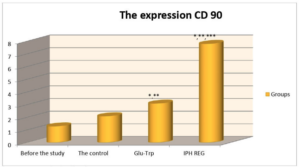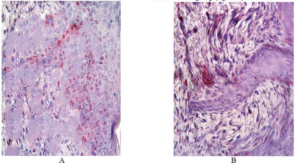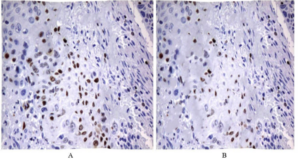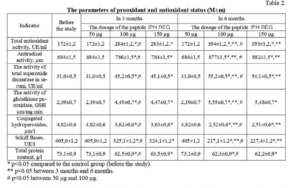
The article describes the result of biological and clinical regenerative effects of the peptide IPH REG. The studies confirm the regenerating and antioxidant properties of the peptide IPH REG according to the expression of genes and biologically active molecules on cell culture. The data obtained confirm the high ability of the IPH REG peptide to repair damaged DNA sites and cell regeneration. The article described that the peptide PH REG has a high ability to regenerate tissues after mechanical damage. The application of the peptide IPH REG shows a high ability to complete reparative regeneration. The application of the peptide IPH REG contributes to a significant increase in the expression of Sir2 protein in the studied patients, which indicates the high activity of the peptide IPH REG as a tissue regenerator in relation to the regulation of gene expression and elimination of DNA damage, which confirms the ability of the peptide IPH REG to repair damaged DNA sites. It is recommended to use the peptide IPH REG as a tissue regenerator and antioxidant.
The study of the effects of peptides has a great interest today. Peptides have the same structure as proteins, but the size of these molecules is smaller. It is also important that short peptides are a natural metabolic product in the body and they can’t be detected in blood or urine. That’s why, it is interesting to study the effects of peptides on cell cultures [1,2,5].
The peptide IPH REG has a regenerating, antioxidant and reparative effect, which is due to the ability to repair DNA damage. The peptide IPH REG is regulate cell activity, interacting with specific receptors. They activate certain genes involved in the process of renewal of the extracellular matrix and cell proliferation, which causes its high ability to regenerate cells and tissues.
There is a great interest in the search for new forms of therapeutic and prophylactic drugs that have regenerative and antioxidant properties [3,4].
The aim of this study
was to identify biological and clinical regenerative effects of the peptide IPH REG.
We conducted 3 areas of research to identify the biological and clinical effects of the peptide IPH REG:
In a cell-based study we selected embryonic stem cells to study the cytostatic, immunomodulatory, geroprotective and oncoprotective properties of the peptide IPH REG. These cells belong to the pluripotent type, which means that they can be differentiated into all three primary germ sheets: ectoderm, endoderm and mesoderm. Organs and glands of the urine-sexual and other systems are formed from these primary germ sheets in the future. The human embryo transfomes the blastocyst stage in 5-6 days after fertilization. The stem cells are obtained from the blastocyst.
We assessed the biological active markers. We used immunofluorescence technique using primary antibodies to ENT-y (1:100, Abeam), CD90 (1:250, Abcam), INK-ATTAC (1:75, Abeam), p53 protein (1:50, Abeam).
We have created the following groups for the study: 1 group — the study of molecular expression before the study; 2 group-control (we added the culture medium, incubation with serum albumin); 3 group — we added the control dipeptide Glu-Tip at the concentration of 100 micrograms (mcg); 4 group — we added the peptide IPH REG at a concentration of 100 micrograms (mcg). We selected the peptide Glu-Tip with the immune properties and well described in the literature as a control.
The PCR method was used to measure the level of gene expression using Novocastals reagents and sets of monoclonal antibodies produced by Biosource (Belgium). We used confocal microscope Olympus FluoView FV1000 with indicator of 200, 400, 600. We conducted the measurement of the expression in %.
We have chosen the most commonly used species of laboratory animals for the study for the experiment recommended by the Ministry of Health of the Russian Federation in the Manual for preclinical studies of drugs – rats.
We created an experimental model of the development of oxidative stress in rats, which led to cell damage and disruption of further repair processes. The development of stress reactions was judged by the level of Ki67 protein expression as a marker of proliferative activity,
We also created mechanical damage to the skin of rats to assess the regenerative properties of the peptide. The expression of PCNA – nuclear antigen of proliferating cells, which gives an idea of reparative regeneration, was evaluated. The animals under ether anesthesia on the lower part of the back hair was removed, the skin was treated with 70% ethanol and scissors stabbed full of skin wound with a diameter of 10 mm.
We was studied 60 rats at the age of 17,5±1,1 months and weighing 419,6±9,5 g. All procedures of animal keeping and testing were carried out in accordance with standards ISO 10993-1-2003 and GOST RISO 10993.2-2006. The rats were divided into 2 groups — the control (n=30) and the main group (n=30). The rats of the main group were given orally through a pipette-dispenser a solution consisting of water for injection in a dosage of 1 ml, in which the lyophilized powder of IPH REG peptides was dissolved in a concentration of 0.59 micrograms (mcg) per rat body weight per day for 30 days. A pipette-dispenser allowed to control the volume and the fact of liquid consumption.
The rats were killed after 30 days. Then the urine bladder was removed, fixed by immersion in a solution of 4% paraformaldehyde in phosphate buffer (PBS pH = 7.3) for 24 hours at a temperature of 4 °C. We produced slices with a thickness of 20 µm using cryotome of Leica CM 1510S model (Germany). Then the sections were mounted on a slide and stained with hematoxilin and eosin. We used the Olympus Dal microscope for the study. We also assessed the biological active marker : Ki67 (1:100, Abcam) – Cell Marque Ki67 (Cell Marque, CI IA, Positive control slides: 275S). The Danet criterion was used to assess the reliability of the difference in the results obtained in the groups before the use of the peptide, compared with the groups after the application of the peptide IPH REG.
The clinical studies of the peptide IPH REG were conducted in 76 patients aged 25 to 60 years (mean age was 37.1±1.5 years). We conducted studies the effectiveness of peptides in the dosage of 50 jig (n= 75 people) and 150 mcg (n=76 people) to assess the effectiveness of the dose of 1001,1g (n=76 people) for the peptide IPH REG.
The peptide IPH REG was administered orally: 1 capsule (100 p.g peptide) 1 time per day for 30 days, then 30 days a break in the medication. And repeat the same course for another 30 days, again 30 days a break in the medication – and the third course for 30 days. The total course was 6 months (3 courses of 30 days and 3 a break in the medication of 30 days). We studied the effectiveness of the improved management scheme of such patients using the peptide IPH REG after 3 and 6 months. The control values was selected the results before the study.
The efficacy of the peptide IPH REG was evaluated on the basis of the dynamics of the Sir2 proteins and protein pl6INK4a, the dynamics of the activity of prooxidant and antioxidant systems were carried out on spectrophotometer Hitachi U-29 (Japan).
We used standard statistical methods of medical and biological research.
The biological analysis of regenerative effects of the peptide IPH REG on cell culture
The figure 1 shows that the application of the peptide IPH REG increases the production of interferon gamma, which suggests the high antioxidant capacity of the studied peptide.


*1p < 0.05 compared to baseline data;
** p < 0.05 compared to control;
*** p < 0.05 between the indicators of the level of expression used Glu-Trp and the peptide IPH REG.
Fig. 1. The expression of the IN-y in cell culture.
The Figure 2 shows that the application of the peptide IPH REG increases the production of CD90, which is in a minimum amount in the studied cells, which suggests a high antitumor ability of the peptide under study, since CD90 is an antiapoptotic factor in relation to lymphoid cells, especially T-lymphocytes, and a decrease in its expression in the population of neurons or lymphoid cells leads to the development of neurogenic tumors, lymphoblastoses and other tumors.


* p < 0.05 compared to baseline data; ** p < 0.05 compared to control; *** p < 0.05 between the indicators of the level of expression used Glu-Trp and the peptide IPH REG.
Fig. 2. The expression of the CD 90 in cell culture.
The Figure 3 shows that the application of the peptide IPH REG increases the production of INKATTAC, which helps to restore the functional activity of cells and implements its effects through the activation of the synthesis of proapoptotic transcription factor p53, respectively, providing a regenerative effect and showing a high ability to repair.


A- Before the study
B- After the application of the peptide IPH REG
Fig. 3. The expression of 1NK-ATTAC in human cell culture after the application of 1PH REG peptide. Con focal
microscopy X400.
The effect of the peptide IPH REG on the expression of p53 protein in cell cultures is presented in figure 4. The application of the peptide IPH REG increases the production of protein p53, which is a transcriptional factor and acts as a suppressor of malignant tumor formation by the way of activating apoptosis in the tissues. This results lead to the conclusion about the reparative and regenerative properties of the peptide IPH REG.


* p < 0.05 compared to baseline data: ** p < 0.05 compared to control: ***p < 0.05 between the indicators of the level of expression used Glu-Trp and the peptide PRO REG.
Fig. 3. The effect of the peptide IPH REG on the expression ofp53 in the cell culture.
P53-dependent apoptosis also avoids the accumulation of mutations. In the case when mutations have already arisen, p53-dependent apoptosis allows to eliminate this potentially dangerous cells. On this fact we can make a conclusion about the regenerating and reparative action of the peptide IPH REG.
We found that the PCNA expression revealed proliferation among keratinocytes of epidermis and hair follicles, dermal cells, vascular endothelium. The morphometric study of the percentage of proliferating keratinocytes showed that after the application of the peptide IPH REG, the PCNA expression was significantly lower than 17.8±1.2 % in the control group, in which the peptide IPH REG was not used, which was 31.2±2.2%, p<0.05 compared with the control group. These results indicate that in 1 month after the application of the peptide IPH REG in a state of oxidative stress and mechanical tissue damage, the proliferation of keratinocytes reaches physiological values, which amounted to 19.1±1.6%, and in the control group — remains at a high level, which is associated with a violation of the ability to repair tissues after mechanical damage. Such disorders occur against the background of oxidative stress in the body as the main mechanism for reducing the regenerative properties of the body. These data indicate incomplete reparative regeneration in the control group (figure 4).


A – without the application of the peptide IPH REG.
B – with the application of the peptide IPH REG
Fig. 4. The expression PCNA. Heinatoxilin and eosin X 400.
The application of the peptide IPH REG shows high efficiency to complete reparative regenerat. We found that the application of the peptide IPH REG reduced the expression Ki67 protein in 1.6 times compared with the results without the application of the peptide IPH REG (Figure 5).


A – without the application of the peptide IPH REG.
B – with the application of the peptide IPH REG
Fig, 5. The expression Ki67 protein. Ilematoxilin and eosin X 400.
Thus, the peptide IPH REG has a high ability to regenerate tissues after mechanical damage. Ki67 protein is a well-known marker of cell proliferation. It reduced increased expression of Ki 67 protein, which develops against the background of oxidative stress, to indicate the presence of antioxidant action and high regenerative ability.
We obtained the data showing the effect of the peptide IPH REG on the expression of molecular markers of Sirtuins Sir2 with the ability to regenerate and repair, and Pl6INK4a proteins increasing with increasing oxidative stress (Table 1).


Thus, we found that the application of the peptide IPH REG contributed to a significant increase in the expression of protein Sir2 in the studied patients in 1.7 times after 3 months of use and in 2.5 times after 6 months from the baseline, which indicates a high activity of the peptide IPH REG as a tissue regenerator in relation to the regulation of gene expression and elimination of DNA damage, which confirms the ability of the peptide IPH REG to repair.
The based on the obtained data on the activity of pl6INK4a protein after the application of IPH REG peptide (table 1), we suggested a high antioxidant activity of the studied peptide. We have built a curve of the dynamics of the expression of niRNA pl6INK4a (%) depending on the time of the application of the peptide IPH REG at a dosage of 100 mcg as an effective optimal for this peptide (Figure 6)


Convention:
The X-axis — time intervals (day);
The Y-axis – the area of pl6INK4a mRNA expression (%).
The dynamics of the square in the expression of p16INI0a mRNA was significantly reduced in a geometric progression after 90 days the application of the peptide IPH REG, which confirms the antioxidant effect of the studied peptide.
We have studied the prooxidant and antioxidant status of patients (Table 2).


Before the study we found signs of a moderate decrease in the activity of the antioxidant defense system of the blood and an increase in the (stress) level of free-radical activity.
After the application of the peptide IPH REG in a dosage of 100 μg, there was a significant increase in the parameters of the antioxidant system and a decrease in the level of free-radical activity.
Thus, the application of the peptide IPH REG in a dosage of 100 μg provides effective antioxidant and pro-oxidant protection, normalizing the parameters after 3 months of the application.
We haven’t found significant differences between the results in the application of 100 mcg and 150 mcg in all the studied parameters like in 3 months as in 6 months. Also, we have not found significant differences between the indicators in the application of 50 mcg and before the study on all parameters. This fact proves that the effective optimal dosage for the peptide IPH REG is 100 μg.
The studies confirm the regenerating and antioxidant properties of the peptide IPH REG according to the expression of genes and biologically active molecules on cell culture. The data obtained confirm the high ability of the IPH REG peptide to repair damaged DNA sites and cell regeneration.
It has also been proved that the peptide IPH REG has a high ability to regenerate tissues after mechanical damage. The application of the peptide IPH REG shows a high ability to complete reparative regeneration.
The peptide IPH REG peptide has antioxidant and regenerating properties, proven in the experiment of reducing the oxidative effect in oxidative stress, expressed in a decrease in Ki67 protein expression according to the experimental model.
Thus, the application of the peptide IPH REG contributes to a significant increase in the expression of Sir2 protein in the studied patients, which indicates the high activity of the peptide IPH REG as a tissue regenerator in relation to the regulation of gene expression and elimination of DNA damage, which confirms the ability of the peptide IPH REG to repair damaged DNA sites.
The application of the peptide IPH REG in a dosage of 100 mcg provides effective antioxidant and pro-oxidant protection, normalizing the parameters after 3 months of the application.
Peptide IPH REG is well tolerated by oral administration in an optimal effective dosage of 100 mcg, has no side effects and can be widely used as a therapeutic and prophylactic dietary supplement.
It is recommended to use the peptide IPH REG as a tissue regenerator and antioxidant.
With the support of Ideal Pharina Peptide GIVIBH, Ferdinandstr. 11 61348 Bad Homburg